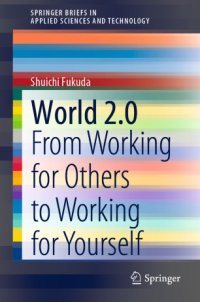
Ebook: World 2.0: From Working for Others to Working for Yourself
Author: Shuichi Fukuda
- Tags: Life Sciences, Computer Appl. in Life Sciences, Communications Engineering Networks, User Interfaces and Human Computer Interaction, Information Systems Applications (incl.Internet), Industrial and Production Engineering
- Series: SpringerBriefs in Applied Sciences and Technology
- Year: 2020
- Publisher: Springer International Publishing
- Edition: 1st ed.
- Language: English
- pdf
This book explores on how the Internet of Things (IoT) will change society by bringing living and non-living things together. The IoT is currently attracting considerable attention, but most of the discussions focus on engineering aspects alone. The IoT, however, is not an extension of traditional engineering, where humans and machines are separated. Instead it connects humans and machines, enabling them to work together as a team: the IoT Connected Society.
In traditional engineering, our knowledge and experience of physical and non-living things plays a key role, but such knowledge and experience alone are not enough. We need to introduce life science approaches and integrate them into physical science to really develop the IoT connected society.
In addition, the Internet is not only a tool for delivering messages: it is a broader communication tool. In the IoT connected society, living things and non-living things communicate in complex ways. Machines
1. Introduction
2. Emerging Industrial Revolution
3. IoT: What makes it different from the past revolutions
4. World is changing
5. Engineering: How It was developed so far
6. Humans: Their characteristics
7. Value is changing
8. Adaptive team organization and management
9. Integration of Physical Science and Life Science
10. Summary
can provide humans with a improved situational awareness and advice, and together they can communicate to develop a better, happier society.
Thus, this book makes the case that to make the IoT connected society a reality, we need to integrate the physical and life sciences and develop a new science for the next generation of engineering.